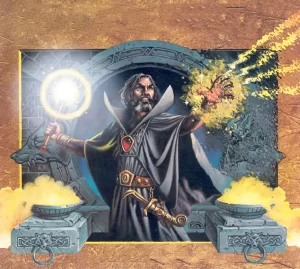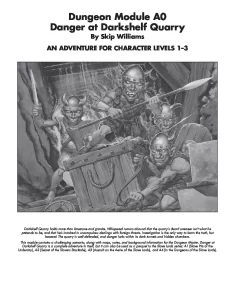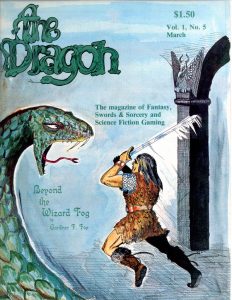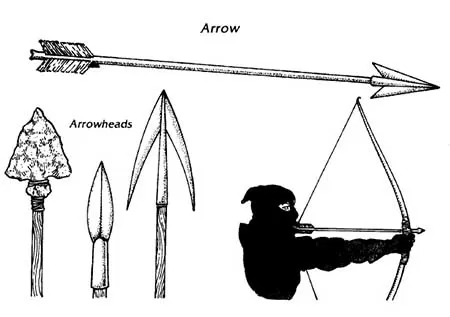
There are as many different types of weapons as there are reasons for using them. A fair warning, though: a weapon is only as effective as the hero who wields it. Sometimes, a smaller, less lethal-looking weapon may be called for. Most of the entries that follow include commentary from distinguished adventurers. Heed their advice, look over the list carefully, and choose well.
Arrows
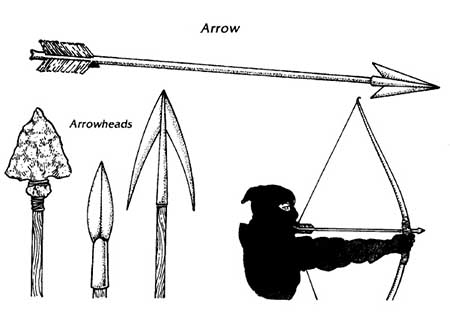
In general, arrows range in length from 20 to 40 inches. The feathers, or fletching, of the arrow consist of two or more feathers set coaxially to the shaft. This gives the arrow its aerodynamic lift. If the feathers are instead set diagonally, the arrows rotates in flight. Goose feathers and parrot feathers are used most often in fletching, though pressed paper and leather are sometimes used.
The flight arrow, as its name implies, is built for distance. These are lightweight arrows and are often used for hunting. Most of these arrows are made of ash or birch and are 30 to 40 inches long.
An incendiary arrow is any arrow type (except bone or stone) with a wad of hemp soaked in a bituminous substance (such as tar) placed just beneath the head. The hemp is lit before the arrow is fired. In addition to its normal damage, the arrow causes one additional hit point of fire damage on the round of impact unless the target makes a saving throw vs. death magic. At the DM's option, flaming arrows may ignite combustible materials contacting it.
Sheaf arrows, also known as war arrows, are heavier arrows with less range than flight arrows, but cause more damage. The arrowheads are steel and quite sharp. Sheaf arrows are used in warfare and can be fired only by long bows. These arrows range in length from 20 to 27 inches.
Stone arrows are considered flight arrows for game purposes, except that the stone arrowheads cause less damage and have a tendency to shatter if they impact armor or similarly hard surfaces. If a stone arrow hits any object made of metal, stone, or a harder substance, it has a 20% chance of surviving the hit without damage to the arrow. Stone arrowheads are almond shaped or rhomboid and are usually made from stone splinters of flint or obsidian.
Caltrop
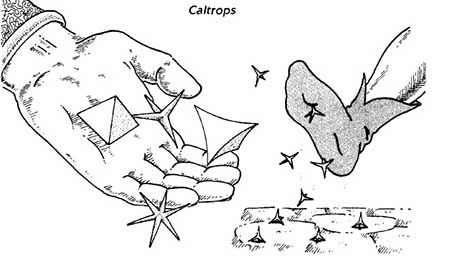
A caltrop is a metal ball bristling with metal spikes or prongs. When a caltrop is left on the ground, there is always at least one spike standing more or less upright, ready to pierce the foot of the unwary. In order to be effective, at least 10 caltrops must be dropped in an area of 25 square feet (a 5' x 5' square). Each character entering the area must make a saving throw vs. paralyzation. A creature moving through the area at half speed doesn't need to make the saving throw. Failure means that the pursuer has stepped on a caltrop, suffering 1 hit point of damage. The character will be able to move at only one-half his normal rate until the caltrop is dislodged from his foot. The victim must also make a second saving throw vs. paralyzation, with failure indicating that the character is lame for 24 hours (unless magically healed) and can move at only one-third his normal movement rate. In any case, the victim must spend one round removing the caltrop from his foot.
If half the number of caltrops are dropped in an area (five in a 25 square foot area), the first save is made with a +4 bonus. For every five extra caltrops over the required 10 dropped in a 25 square foot area, the saving throw is made at a - 2, up to a maximum penalty of - 6. A new saving throw must be made for each five-foot section entered in which caltrops have been dropped. Characters moving at less than one-third their normal movement rate through an area of caltrops need not make a saving throw. They are moving slowly enough to avoid the caltrops (although they must be able to see the terrain in order to do so).
Cestus
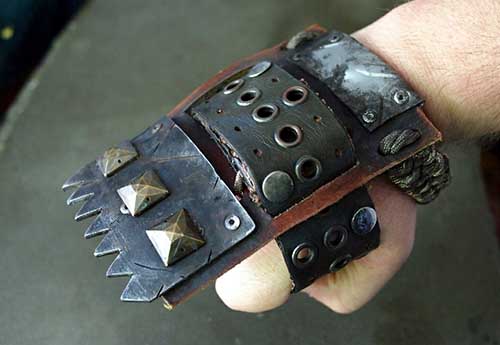
The cestus is a leather glove that has spikes and razor edges. on the back and across the knuckles. Other forms of cesti are loaded with lead or other heavy filler in order to give a punch more force. The weapon is mainly used as a gladiator weapon in the arenas of sport.
The damage caused by the cestus (1d4 vs. small and medium creatures; 1d3 to large) replaces the damage caused by a punch. Although this may seem to be a disadvantage, remember that punching damage is temporary while damage from the cestus is permanent until healed. There is no proficiency in the cestus, though a warrior can spend a proficiency slot and specialize in it.
"A cestus isn't a true weapon of battle. It's just a cruel way to add damage to a fighter's punch. A cestus is a good weapon only if you like to punch opponents. But since most combatants inside and outside the arena have missile weapons, spells, long melee weapons such as spears, polearms, and swords, or benefits due to size, a fighter using a cestus may find himself badly chewed up, if not dead, before closing in enough to use the weapon. And using a cestus in tavern brawls will probably accomplish little more than calling the city guard's wrath on the owner of the cestus. The cestus is just a dramatic device meant to draw blood and make a contest look more terrible. Few monsters will care about the drama produced by a cestus if the glove is used in real combat."
Tisha, Swordswoman Extraordinary
Club
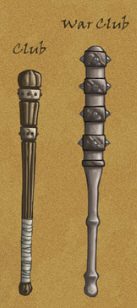
Most clubs are stout, hardwood sticks, narrow at the grip and wider at the end. This simple weapon has been used since mankind first began using tools. Anyone can find a good stout piece of wood and swing it; hence the club's widespread use. The club is the ancestor of the mace, since warriors eventually fitted their clubs with spikes and metal heads in order to increase their deadliness.
As centuries passed, cultures began embracing civilization and advanced technology. They looked down on the club as a primitive tool and a barbarian weapon. Peasants often arm themselves with clubs, sometimes adapting them by adding iron spikes, resulting in the Morningstar. Centaurs are often seen wielding clubs, since sylvan settings have ample wood for fashioning such weapons. Ogres also use clubs, since the weapon does not require brains to use or make.
"Despite the lowly status of the club, it is a useful proficiency. A stout tree branch, a wooden chair leg, or a metal rod all may be considered clubs, and all can be found most anywhere. When an adventurer is without a weapon, knowing how to wield a common stick may save his life. Clubs are common among adventurers. Quarrels City guards who do not intend to shed blood use clubs in law enforcement, thieves who wish merely to steal a purse carry them, and humble peasants or street urchins who cannot afford a sword may wield a stout piece of wood. If anyone anticipates a life filled with tavern brawls, proficiency with the club is a must. Druids favor clubs, since they can cast shillelagh spells on the wood. Carrying a weapon made of wood, an organic, natural material, is preferable to using iron, since many self-respecting druids will use metal weapons only as a last resort."
Archdruid Heather Rose
Crossbow
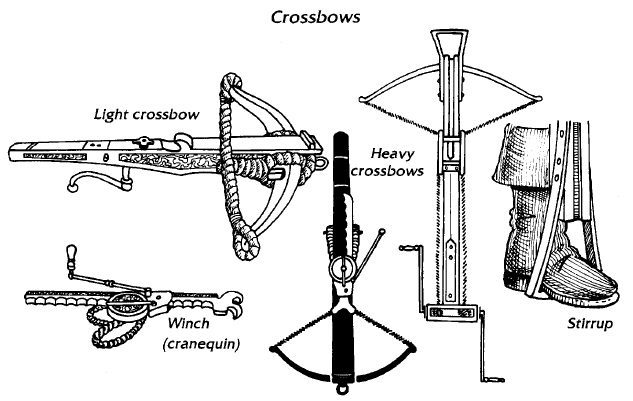
A crossbow is a bow mounted crosswise on a wooden or metal shaft, the latter called a tiller. The bow is usually made of ash or yew. The crossbow fires a quarrel (also called a bolt).
Crossbows are loaded by pulling the string back until it locks onto a nut fitted on the tiller. A man's strength is enough to pull the bow to the locking position, although heavier crossbows with more powerful bows require a mechanical aid.
The most effective of these devices is the windlass, a series of pulleys and crank handles fitted at the crossbow's stock. For crossbows that do not have the windlass, a stirrup is fitted on the front of the crossbow. When resetting the bow, the firer places his foot in the stirrup in order to keep the bow off the ground while he is pulling the string up to the locking position.
The main differences between the light and heavy crossbows are the size of the quarrel and the presence of a stirrup, which is found only on the heavy crossbow. Heavy and light crossbows are more correctly referred to as two-foot and one-foot crossbows, respectively. This term refers to the length of the quarrels. The one-foot crossbow is made with a steel tiller and is quite rugged. It may be easily concealed beneath flowing garments such as cloaks or robes.
It is frowned upon by the more lawful, civilized cities. Although bows cannot be used underwater, the crossbow can, since the tension produced by the weapon overcomes the water resistance. Underwater races such as the locathah, mermen, and tritons use crossbows of both heavy and light varieties.
Hand Crossbow
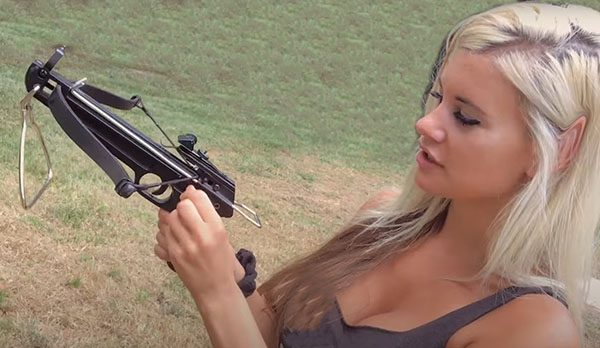
This deadly little bow is a pistol-sized weapon made with a steel tiller. It is more easily concealed than the light crossbow and its use is considered unethical in civilized society. Hand crossbows have a reloading mechanism built into the tiller.
"Apparently, the drow couldn't care less about the hand crossbow's reputation, since they favor this weapon in all encounters. Derro also use hand crossbows, probably a habit they picked up from their fellow subterranean dwellers, the drow. Of all the crossbows, light crossbows were the first to be developed. Their rate of fire and range are their main advantages. But damage potential is less than that of a bow and arrow. Heavy crossbows have better range and damage potential, but they can fire only once every other round. If a warrior does not kill his opponent with the first shot, he may not get another chance. It would be foolish to dismiss the crossbow completely. Heavy and light crossbows have better ranges than their respective bow counterparts, the long and short bows. The best tactic when using a crossbow is to assemble a line of people, all armed with these weapons, who unleash a devastating volley at an enemy. Hand crossbows are easily concealed, have an adequate rate of fire, and good range for such a small weapon. On the other hand, damage potential is worse than that of a dagger, and the weapon may be banned in some lawful kingdoms or cities. Some societies, such as the drow, place poison on their bolts in order to immobilize an opponent."
Emryl Aelorthas, Professional Bowyer
Quarrels
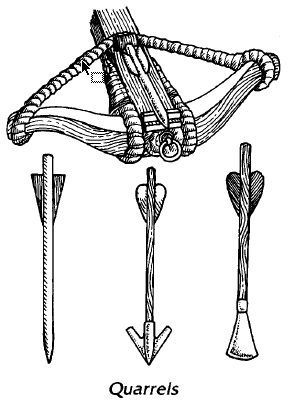
Quarrels or bolts are the ammunition fired by crossbows regardless of the weapon's size. Crossbows are rated as one-footers or twofooters, according to the bolt's length. Quarrels are shaped like arrows, but the shafts are shorter and thicker. The quarrel heads used for warfare are conical or pyramid-shaped iron heads.
European crossbows have existed since the 4th century AD and at first were used primarily for hunting. By 1000 AD, crossbows had been adopted for warfare. Use began to wane upon the advent of the English long bow, for despite the fact that the crossbow was a more powerful weapon with better range and was easier to use in close quarters, the rate of fire of a bow was a huge psychological advantage. The most talented makers and users of the crossbow were the Italians, whose Genoese mercenary crossbowmen were the best in the world.
Although heavy and light crossbows enjoyed a favorable reputation among military commanders, these weapons suffered a bad reputation. The crossbow was so lethal that Pope Innocent II banned its use in 1139 AD. The edict was later changed, however, so that Crusaders could use it against Moslems.
Light crossbows were considered unethical weapons, and were often banned between the 16th and 18th centuries. The light crossbow was primarily used as a hunting weapon.
The crossbow was originally developed in China, culminating in a sturdy, reliable model during the Han Dynasty, circa 206 BC. This particular crossbow model, some scholars believe, was seen as early as about 36 BC by about 100 Roman soldiers who were taken prisoner in Central Asia. Such experiences or the trade routes that eventually opened passed the concept of the crossbow from East to West.
Initially, the European crossbow was made with a wooden stave. This construction, however, does not give optimum power to the bolt's flight. By the end of the 11th century, it is believed that many crossbow staves were made of composite construction, usually horn and sinew in conjunction with wood (usually yew). This method of crossbowmaking came from the Saracens, and the Saracen influence in southern Europe explains why the area became well known for crossbow manufacturing and use.



